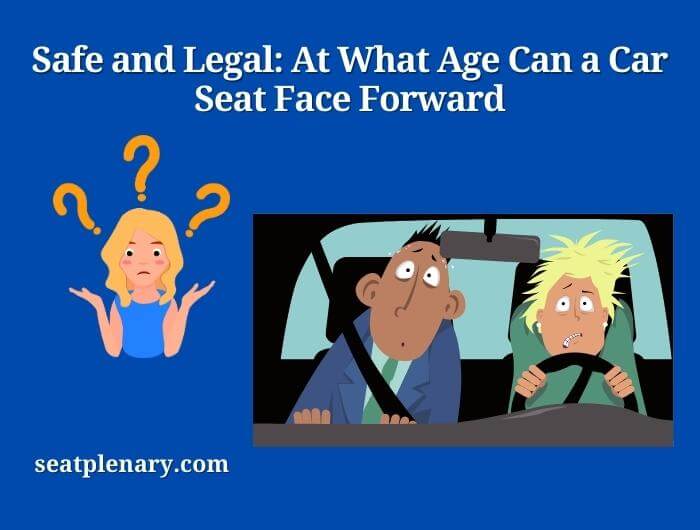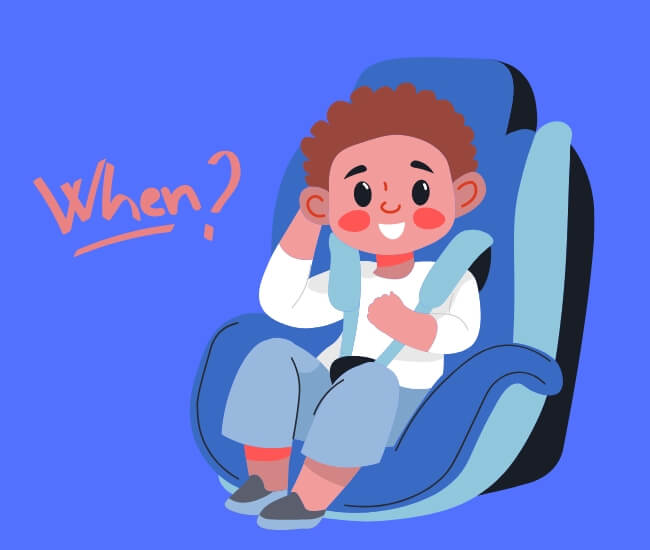Every parent wants to ensure the safety of their children, especially when it comes to traveling in a vehicle. One of the essential safety measures for young children is using a car seat. But as your child grows and develops, you may be wondering when it’s safe to turn their car seat to face forward. This is an important question to consider, as improperly turning a car seat too early can increase the risk of injury in the event of an accident.

From this discussion, you can learn about the age and weight requirements for transitioning to a forward-facing car seat and why rear-facing car seats are recommended for young children. We’ll also provide tips for properly installing and using a forward-facing car seat to ensure maximum safety for your child.
When it’s safe to turn your child’s car seat around, you can give yourself peace of mind knowing that your little one is traveling safely and securely in the car.
Convertible Car Seat Facing Options: Which is Best for Your Child?
Choosing a car seat for your child can be overwhelming, especially considering the different options. Here are some key points to consider when selecting a convertible car seat for your child:
Rear-facing Option:
Convertible car seats have a rear-facing option, which is the safest option for young children. The American Academy of Pediatrics recommends children remain rear-facing until they are at least two years old or until they have outgrown the rear-facing weight and height limits of the car seat.
Forward-facing Option:
Once your child has outgrown the rear-facing option, convertible car seats can be turned forward-facing. Make sure to follow the manufacturer’s guidelines for weight and height limits.
Combination Option:
Some convertible car seats also have a booster seat option for older children. These seats typically have weight and height limits for each prospect, so make sure to follow the manufacturer’s guidelines.
Considering these points, you can decide which convertible car seat-facing option is best for your child. Remember, safety should always be the top priority when selecting a car seat for your child.
Why are Rear-Facing Car Seats Safer for Children?
Regarding car seat safety for young children, rear-facing car seats are widely considered the safest option. Here are some key points to understand why:
Crash Forces:
In a crash, a rear-facing car seat allows the child’s head, neck, and spine to be supported by the car seat shell. This helps to distribute the crash forces over the entire body, reducing the risk of injury.
Size and Weight of Child:
The size and weight of a child affect the amount of force experienced during a crash. Young children have relatively large heads and weak neck muscles, which makes them more vulnerable to head and spinal cord injuries. Rear-facing car seats help to mitigate these risks by providing added support and protection.
Safety Standards:
Safety standards for car seats have evolved to account for the benefits of rear-facing car seats. The American Academy of Pediatrics recommends that children remain rear-facing until they are at least two years old or until they have outgrown the rear-facing weight and height limits of the car seat.
Research and Statistics:
Research studies and crash data consistently show that rear-facing car seats are associated with a lower risk of injury and death for young children. A study published in the journal Injury Prevention found that children under 2 were 75% less likely to die or be seriously injured in a crash when rear-facing.
Easy to Use:
Many car seats now have features that make it easier to use rear-facing car seats, such as adjustable headrests and easy installation systems. While having a rear-facing car seat may seem inconvenient, the added safety benefits are well worth the effort.
With the benefits of rear-facing car seats, parents can make an informed decision about the best car seat option for their child’s safety. Remember, rear-facing car seats are recommended until a child is at least two years old or has outgrown the rear-facing weight and height limits of the car seat.
When is it Safe to Turn Your Child’s Car Seat Forward-Facing?
Regarding traveling in a car with your child, safety should always be the top priority. One of the most important decisions you’ll make is when to turn your child’s car seat forward-facing. Here are some key points to consider:

Follow the AAP Guidelines:
The American Academy of Pediatrics recommends that children remain rear-facing in their car seat until they reach the age of 2 or until they reach the highest weight or height allowed by the car seat manufacturer.
Rear-facing is Safest:
Rear-facing car seats provide the best protection for young children because they support the head, neck, and spine in the event of a crash. This is especially important for infants and young children, whose bones and muscles are still developing.
Consider Your Child’s Weight and Height:
Once your child has outgrown their rear-facing car seat, it’s time to transition to a forward-facing car seat. Make sure to follow the manufacturer’s guidelines for weight and height limits.
Choose a Quality Car Seat:
When selecting a car seat, choose one with a five-point harness, side-impact protection, and easy installation. Look for models tested and certified by organizations like the National Highway Traffic Safety Administration (NHTSA).
Check the Fit:
Make sure the car seat fits properly in your vehicle and that your child is appropriately restrained in the seat. Check the instructions and watch instructional videos to ensure proper installation and use.
By following these guidelines and considering your child’s safety, you can make an informed decision about when to turn your child’s car seat forward-facing. Remember, safety should always be the top priority when traveling in a car with your child.
Tips for Safely Installing and Using a Forward-Facing Car Seat
Some tips for safely installing and using a forward-facing car seat are presented in a table format:
| Tips | Description |
| Read the manual | Always read the car seat manual thoroughly before installing and using it to ensure that you understand the proper installation and use of the car seat. |
| Use the tether strap | A tether strap is a crucial part of a forward-facing car seat, as it helps to limit the forward movement of the car seat in the event of an accident. Always use the tether strap according to the manufacturer’s instructions. |
| Install the car seat in the back seat | The back seat is the safest place for a child’s car seat, and it’s recommended to install a forward-facing car seat in the back seat, away from any airbags. |
| Ensure a secure installation | Make sure the car seat is tightly secured to the vehicle’s seat, with no more than one inch of movement in any direction. |
| Adjust the harness properly | The harness should be snug on the child, with no slack or gaps, and the chest clip should be at armpit level. |
| Don’t use aftermarket products | Please avoid using any aftermarket products, such as car seat covers or strap pads, as they can interfere with the car seat’s safety. |
| Check the car seat regularly | Regularly check the car seat to ensure that it is still properly installed and used correctly, and replace the car seat if it has been in an accident or is expired. |
To follow these tips, parents can help ensure the proper installation and use of a forward-facing car seat and keep their child safe while traveling in a vehicle.
Last Point
It is recommended to keep children in a rear-facing car seat for as long as possible until they reach the maximum height and weight limit the car seat manufacturer allows. The American Academy of Pediatrics recommends that children remain in a rear-facing car seat until at least two years of age.
Rear-facing car seats provide superior protection for a child’s developing head, neck, and spine in an accident and are up to five times safer than forward-facing car seats for young children. By the guidelines for installing and using a forward-facing car seat, parents can help ensure their child’s safety while traveling in a vehicle.
If you want to know are aisle seats better at concerts? The Reply is here.
Frequently Asked Questions
What is the Current Recommendation for When to Turn a Car Seat Forward-facing?
The current recommendation for when to turn a car seat forward-facing is to wait until a child is at least two years old or until they have outgrown the height and weight limits of their rear-facing car seat. This is because rear-facing car seats provide better protection for a child’s head, neck, and spine in a crash. It is essential to follow the manufacturer’s guidelines and state laws regarding car seat use to ensure your child’s safety while riding in a car.
What are the Safety Guidelines for Car Seats After an Accident?
After an accident, using car seat post accident is a safety concern. It’s recommended to replace a car seat after a moderate or severe crash, as it may have been compromised. Even if the damage is not visible, the structural integrity could be compromised, putting children at risk.
Are There Any Exceptions to the Recommended Age for Forward-facing Car Seats?
There may be exceptions to the recommended age for forward-facing car seats in certain situations, such as when a child has a medical condition or physical disability that requires them to face forward earlier. It is important to consult with a pediatrician or certified child passenger safety technician to determine the best course of action for your child. It is generally safest to follow the recommended age and weight limits for forward-facing car seats.
Is It Safe and Legal to Upgrade My Child’s Car Seat to Face Forward at a Certain Age?
As a parent, it’s important to follow car seat age requirements when deciding when to face forward your child’s car seat. In most regions, it is legal to make the switch once your child reaches a certain age, but safety experts recommend keeping them rear-facing for as long as possible.
Can a Child Be Too Small or Too Large for a Rear-facing Car Seat?
Yes, a child can be too small or too large for a rear-facing car seat. It is important to follow the manufacturer’s guidelines for weight and height limits when selecting a car seat for your child. Rear-facing car seats are designed to accommodate a range of sizes, but if a child is too small or too large for their car seat, it may not provide adequate protection in the event of a crash. If you have concerns about the fit of your child’s car seat, consult a certified child passenger safety technician.
What Are the Risks of Turning a Car Seat Forward-facing Too Early?
Turning a car seat forward-facing too early can increase the risk of injury or death in a crash. Rear-facing car seats are designed to provide better protection for a child’s head, neck, and spine, which are particularly vulnerable in a collision. Turning a car seat forward-facing before a child is ready can also result in improper fit and reduced effectiveness of the seat’s safety features. Following the recommended age and weight limits for turning a car seat forward-facing is essential to ensure your child’s safety.
You should be aware of important differences between F150 and F250 seats before making a purchase or attempting to swap them out.
Relevant Resources:
